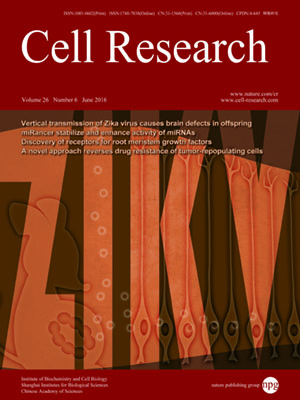
Volume 26, No 6, Jun 2016
ISSN: 1001-0602
EISSN: 1748-7838 2018
impact factor 17.848*
(Clarivate Analytics, 2019)
Volume 26 Issue 6, June 2016: 674-685
ORIGINAL ARTICLES
Signature motif-guided identification of receptors for peptide hormones essential for root meristem growth
Wen Song1,*, Li Liu2,*, Jizong Wang1, Zhen Wu1, Heqiao Zhang1, Jiao Tang1, Guangzhong Lin1, Yichuan Wang2,3, Xing Wen2, Wenyang Li2, Zhifu Han1, Hongwei Guo2,3 and Jijie Chai1
1Innovation Center for Structural Biology, Tsinghua-Peking Joint Center for Life Sciences, School of Life Sciences, Tsinghua University, Beijing 100084, China;
2The State Key Laboratory of Protein and Plant Gene Research, Peking-Tsinghua Joint Center for Life Sciences, Academy for Advanced Interdisciplinary Studies, College of Life Sciences, Peking University, Beijing 100871, China
3Department of Biology, South University of Science and Technology of China, Shenzhen, Guangdong 518055, China
Correspondence: Jijie Chai, E-mail: chaijj@tsinghua.edu.cn; Hongwei Guo, E-mail: hongweig@pku.edu.cn; Zhifu Han,(hanzhifu@mail.tsinghua.edu.cn)
Peptide-mediated cell-to-cell signaling has crucial roles in coordination and definition of cellular functions in plants. Peptide-receptor matching is important for understanding the mechanisms underlying peptide-mediated signaling. Here we report the structure-guided identification of root meristem growth factor (RGF) receptors important for plant development. An assay based on a signature ligand recognition motif (Arg-x-Arg) conserved in a subfamily of leucine-rich repeat receptor kinases (LRR-RKs) identified the functionally uncharacterized LRR-RK At4g26540 as a receptor of RGF1 (RGFR1). We further solved the crystal structure of RGF1 in complex with the LRR domain of RGFR1 at a resolution of 2.6 Å, which reveals that the Arg-x-Gly-Gly (RxGG) motif is responsible for specific recognition of the sulfate group of RGF1 by RGFR1. Based on the RxGG motif, we identified additional four RGFRs. Participation of the five RGFRs in RGF-induced signaling is supported by biochemical and genetic data. We also offer evidence showing that SERKs function as co-receptors for RGFs. Taken together, our study identifies RGF receptors and co-receptors that can link RGF signals with their downstream components and provides a proof of principle for structure-based matching of LRR-RKs with their peptide ligands.
10.1038/cr.2016.62
FULL TEXT | PDF
Browse 2123


